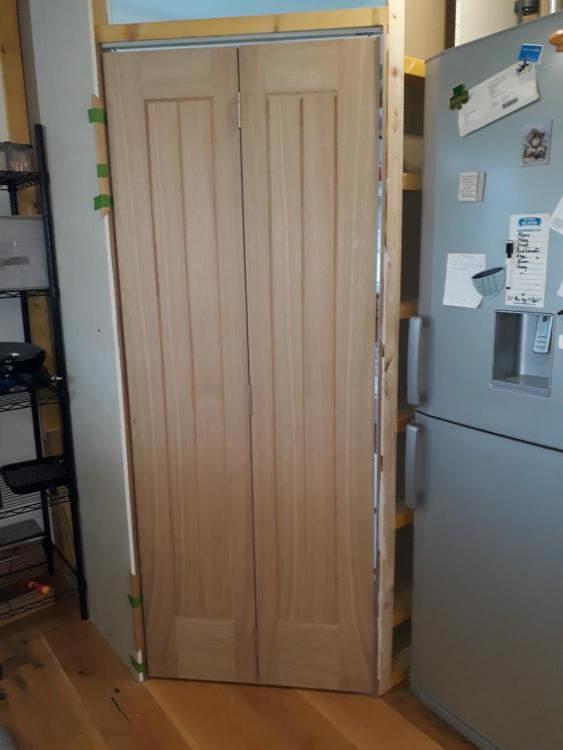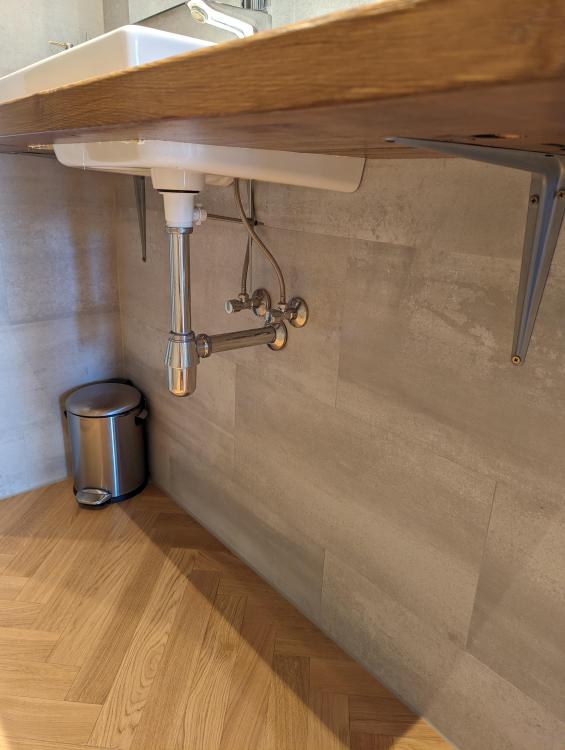Leaderboard
Popular Content
Showing content with the highest reputation on 11/25/23 in all areas
-
That's the main shelves finished, the bottom stone one now the right size and the two wooden ones at the bottm. And now all the shelves are in, the bifold oak door is fitted with the oak door facings both sides. And with the door shut Outside plasterboard and all the trims around the door opening to fit. That won't happen yet until we know what shelves we are putting on the left wall, as no doubt dwangs will be needed to the frame for those before the outside gets boarded.3 points
-
This is not really an introduction, but I didn't formally introduce myself when I got into buildhub more than a year ago. Work is basically done, and it's now official: my place has gone from having an energy rating of F to having an energy rating of B! In particular, this counts as "bâtiment basse consommation en rénovation". French energy rating is insanely hard; of the roughly sixty places I visited when I was buying, only two had a B - one was new, and the other one had town heating (still a rarity) due to being next to an incinerator. This is just to say that I am very, very grateful to everybody who helped here. I don't know what I would have done otherwise. The diagnostician's only recommendations are: - to install MVHR (not sure that's feasible in a house from 1930?) - to check on airtightness (I'll borrow a thermal imagining camera once it gets seriously cold - is there anything else I should do?). When asked, he also said that installing solar panels and hooking them up to hot water generation could be interesting. (Local peculiarities: it's sunny only in summer, and it is no longer possible to sell excess electricity back to the State.) Thank you again!2 points
-
That does not just apply to a "plant room". The noise of a central heating circulating pump reverberates around anywhere there are pipes. And i made the mistake of routing the flow and return from the ASHP under our bedroom floor. If i were doing it again I would have taken a slightly longer route and put it under the bathroom floor instead. I would not say it is "loud" but when I want to be quiet, I want things like that silent.2 points
-
I like to close threads off. The one thing that annoys me a little about some threads on here is people start them, lots of people contribute suggestions and you never find out how it ended and it’s helpful to know for the future when other folk have a similar problem. They replaced the window and the tint matches perfectly. However, they also damaged all the aluminium cladding and window beads in the process so I lost my rag a bit about that. They have all subsequently now been replaced too. This all started back in April when the windows were delivered two days earlier than planned and just before the scaffolding went up. I didn’t want to take them as the likelihood of them getting damaged was high. But Heb Homes knew better and said they’d accept the risk. Sure as eggs is eggs a window got smashed and everyone on-site denied it was them. The scaffolding company said it’s what insurance is for 🙄 I pointed out that it wasn’t the money as the timber kit company were covering that. It was the consequential hassle this would generate for me trying to get this fixed and I was right about that as it took 6 months and wasted hours of my time. No idea how much this cost Heb and Nordan but a lot. The good news the two incorrect glazing units were put to good use in some garden rooms in the local town.2 points
-
I did similar, a blower door on the door through to the garage, sucking air out of the house. It was very crude, big bits of cardboard, some duct tape, and old office desk fan and some strips of wood to support the fan. With the fan extracting air from the house, you can go round feeling or listening for any signs of air coming in. Also once the fan has been running for a while, a good test is to go and open a window or a door, if you are reasonably air tight, you will get a big whooosh of air enter as you open the door ow window showing the house had depresurised. Getting an actual measure of air tightness would be nigh on impossible as nothing is calibrated, but it gives you an idea of any air leaks you might have.2 points
-
So I received 2 council tax bills. One for 22-23 one for 23 -24. Total £9k+ The old house that I bought in April 22 was in shit state and was going to be demolished from the start. I ignored them for a while due to being flat out on my build then last week I got a final demand and threatened with court action in 14 days. After a few sleepless nights I took the bull by the horns and spent a couple of hours writing a letter and printing lots of date stamped photos and took on the next battle with my scanner and sent them a lengthy email describing why I think I shouldn't pay any council tax. I sent the hard copies by recorded snail mail then left it a couple of days before calling them. Result !! I don't have to pay anything for the first year and only have to pay for the time elapsed after one year up to demolition date. so effectively 2.5 months. long term empty rate. I will wait for confirmation of the first reductions then go back and argue the toss about the 2 and a half months which wouldn't have occurred if the council hadn't delayed me for months waiting for a section 106 to be printed out. They also said we get 3 months free after completion. This may take a while. 😜2 points
-
The trouble with small projects is that it's often cheaper to slightly overspec a design to save the SEs time and fee for getting everything to the last decimal point. In any case your spec doesn't sound mad. A good builder should be able to give you a feel for if the SE has designed someone sensible and maybe point you towards someone more suitable if they think yours has gone totally overboard. As an aside (without having costed it) YouTube told me recently that Spaz do impact driven screws that could save a good chunk of labour to replace the M20 bolts.1 point
-
Agree. Your right Joe.. not a good idea squeezing stuff together like that. Good spot both.1 point
-
https://assets.publishing.service.gov.uk/government/uploads/system/uploads/attachment_data/file/1124733/Approved_Document_B__fire_safety__volume_1_-_Dwellings__2019_edition_incorporating_2020_and_2022_amendments.pdf1 point
-
All fire doors in all buildings used to require automatic closers. That requirement was relaxed for private dwellings (except between the house and an integral garage, as your BCO requires), but in all other respects a fire door is a fire door. The change followed a report in 2003 identifying that closers were causing over 30,000 finger-trap injuries each year, and that many people disabled the closers or wedged the doors open.1 point
-
You have massively misunderstood how the VAT reclaim process works. https://www.self-build.co.uk/our-guide-claiming-back-vat-self-build/ https://www.gov.uk/vat-building-new-home/how-to-claim1 point
-
I don't get this question. your VAT reclaim and the contractor's VAT reclaim have nothing to do with each other. Your contractor shouldn't be charging you VAT. if they are then there's nothing you can do to reclaim it. anything you've purchased can go in your VAT reclaim.1 point
-
Don’t forget to factor in the noise generated from whatever is in your plant room/cupboard . Our no1 mistake was having ours in a location adjacent/below to otherwise quiet rooms - study & bedroom. Didn’t appreciate the internal pumps and gubbins for our ASHP / central heating system make a tremendous noise when on. Now having to, with difficulty and limited success, retrofit sound insulation. Eventually I’m going have to pull up a bedroom floor above our plant cupboard to install enhanced sound insulation. If you must locate it centrally and near rooms please consider enhanced sound insulation at very least. I would never again have a plant room/ cupboard adjacent to a bedroom. If your house is in a quiet area and well insulated any internal noises even low buzzes or hums could be quite noticeable.1 point
-
1 point
-
The Scottish system is better, you would not get your building warrant until all such details are properly detailed and agreed and confirmed by BCO to meet building regulations. Then as long as you build to the drawings you should not have issues.1 point
-
I agree, luckily my ecologist was very reasonable and allowed me to build bat boxes myself into my garage to their basic design (left over ply etc), also when I won the planning appeal the officer told the planners they were not qualified to overrule the ecologist and insist bat boxes were also installed in the house 👍.1 point
-
Like many I started down the "plant room" idea. I soon realised in my case at least it would not work. The only things in my "plant room" now is the MVHR unit, a pump and an expansion vessel for the heating circuit and some of the electrical controls for the ASHP. The ASHP is a monoblock so most of that is just in a box outside. CU is on the wall in the utility room where it is handy. HW cylinder is in an airing cupboard in the corner of a bedroom, positioned for short HW pipe runs i.e. at the centre of the points of use. Kitchen water goes direct from the cylinder, bathrooms (in the opposite direction) have a distribution manifold in the inter floor space again to get the HW runs as short as possible, anywhere else would have made the HW runs longer. There is a trap door in the ceiling of the utility room to access this. I am reminded of my plumber friend that put everything in the plant room and ended up with his hot water tank literally as far from the kitchen as it could possibly be.1 point
-
Depends what else is going in your plant room. HWC, MVHR, UFH manifold and controls, centralised hot and cold water manifold, all your electrical equipment etc. I put ours in the centre with an outside wall and all of our plant equipment is in it apart from the water treatment which is in the garage. The benefit is all of our pipe, ducting, cable runs are relatively short and everything is in one place. The downside is it’s quite tight for space as I could have done with another 300mm of width and routing it all up into the ceiling wasn’t easy.1 point
-
No really within reason, but longer pipes mean bigger pressure drops and eventually larger pipes. If it's a new build why even concider a gas boiler. We put in gas boiler, and now have ASHP. UFH manifold can go anywhere, you are just limiting the circuit pipes to 100m. Cylinder can go anywhere also, but close to UFH and ASHP makes for easy plumbing.1 point
-
First, my house isn't airtight so I check airtightness room by room, but you could do the same putting the fan in an external doorway or window and doing the whole house at once. What I do first bring a bowl of cold water, sharpie (marker pen), dust mask and eye protection into the room (I'm sensitive to dust). Then I put my "blower door" into the room's doorway and seal the gaps at the side with masking tape. I put on the PPE, turn the fan on and go round the room feeling for big draughts. If it's a room I'm going to redecorate I mark where the draughts are on the wall/floor. Otherwise I use post-it notes or similar. I seal these up. With mortar if they're big, or expanding foam if no alternative, or sealant if they're small. Or I stuff insulation material in if they're tricky to get to any other way. Then I wet my hand and go round using the front/back of the hand to trace where the smaller air leaks are. They can be a pain to track down because of the way air flows - where you feel a draught may be caused by a leak half a metre away, instead of where you're feeling it. And then I seal them. It's a slow job but satisfying. The biggest pain point is forgetting to bring something into the room before I tape the door in the door frame. E.g. the sealant gun. That's why in my video it isn't sealed - the room is airtight enough now that the gap round the blower door doesn't matter, and that lets me get in and out of the room easily. I have also used https://www.soudal.co.uk/pro/products/coatings/air-and-vapourtight-coatings/soudatight-lq, a cheaper alternative to Blowerproof or PassivePurple to seal around my joist ends under the floor. I applied it half the thickness it said so we'll see how long it lasts.1 point
-
That is meaningless though. / bco too. This is a technical matter but for your family's safety. It needs a proper read through the regs with the design to hand. It's the Architect's job if retained. It isn't the bco's job to design your house so be patient with them.1 point
-
Definitely rust leaching through, I'll get a pic if I can. Thanks for all that info @Nick Laslett, however these are internal steels in a heated environment, so classed as C1 I think.1 point
-
Can you find a similar door or window which is PAS24 and is similar, provide that certificate to your building control officer while explaining that your manufacturer no longer exists. I had an issue with a window being larger than the size that was PAS 24 certified by the manufacturer, and so in the strictest sense lacked PAS 24 compliance. I provided a copy of the PAS 24 certificate for the assessed size and explained the situation. My local-council's building control then said it was fine.1 point
-
Nor had I, until recently. The timer is built in, but you will need to find the right button presses to get to the billing menu. They did an update on mine and the menu changed.1 point
-
There are many reasons that urban areas are warmer than surrounding areas. If climate change was solved with single change i.e. 1 technology, or 1 change in behaviour, it would not be a problem. Here is one article that highlights, i think quite nicely, how interactions can be confusing. Hopefully more research like this will kill the bonkers idea of geoengineering the atmosphere. Many people still think that CO2 makes plants grow more, regardless of the temperature they are growing at. Hopefully the second article will help clear this up. Plants are more productive on weekends thanks to cleaner air Satellite data from Europe shows that rates of photosynthesis are higher when aerosol levels in the atmosphere are lower, and there is a regular weekly cycle By Chen Ly 20 November 2023 Aerosol pollution from road vehicles can restrict plants’ capacity for photosynthesis Aleksei Gorodenkov / Alamy Plants in Europe photosynthesise more at the weekend, probably because there is less pollution in the air. Photosynthesis is the chemical reaction that plants use to capture energy from the sun and convert carbon dioxide and water into sugar. With increasing air pollution from wildfires, dust and human activities, Liyin He at the Carnegie Institution for Science in California and her colleagues wanted to see what effect air quality has on photosynthesis. The team analysed satellite measurements of how much light is emitted by the green pigment chlorophyll in the leaves of plants – which corresponds to how much photosynthesis is occurring – across Europe between 2018 and 2021. By comparing this with satellite measurements of air pollution over the same period, the team found that photosynthesis rates increased when there were lower levels of aerosols, a type of pollution that includes dust as well as smoke from wildfires and human activity. These aerosols can stop sunlight from reaching Earth’s surface, which can hamper plants’ photosynthesising capacity. On the other hand, when there is less aerosol pollution in the atmosphere, more sunshine can reach the leaves of plants, says He. The team found that higher rates of photosynthesis occurred at weekends in 64 per cent of Europe. “There’s less traffic and industrial activities on the weekend,” says He. “But during the weekdays, the air is dirtier, so we see a strong weekly cycle.” Furthermore, the team found that aerosol pollution reduced significantly in 2020 compared with other years due to the covid-19 pandemic. As a result, plants were more productive all week long, not just at the weekend. Plants find it harder to absorb carbon dioxide amid global warming A modelling study suggests that increases in photosynthesis have slowed since 2000, opposing previous research that said this effect would remain strong, helping to absorb CO2 from the atmosphere By Jason Arunn Murugesu 10 August 2023 Photosynthesis involves plants using the energy from sunlight to produce glucose from carbon dioxide and water Image navi/QxQ images/Alamy Global warming drying the air may have slowed a rising rate of photosynthesis around the world. With this plant process involving the uptake of carbon dioxide, some researchers hoped that a boost to photosynthesis rates would help to remove the greenhouse gas from the atmosphere, but the latest study suggests this effect has faltered since 2000. Photosynthesis is the chemical reaction that plants use to convert CO2 and water into carbohydrates. Scientists generally think that a rise in CO2 emissions has been leading to more and more photosynthesis, but Jingfeng Xiao at the University of New Hampshire says that few studies have actually looked into this on a global scale. To learn more, Xiao and his colleagues analysed ground measurements taken between 1982 and 2016 from sensors scattered around the world that measure fluctuations in CO2 and water vapour in various environments, such as forests and savannahs. They then used satellite images to estimate plant growth in different locations. Using machine learning, the team combined these datasets to broaden the fluctuation measurements to a global scale. The models suggest that, on average, increases in global photosynthesis levels have slowed since 2000, despite the amount of CO2 in the atmosphere continuing to rise. This is probably due to the rise in the so-called vapour pressure deficit offsetting some of the increase in CO2, says Xiao. This deficit is a measurement of how dry air is. The higher the deficit, the more water evaporates off plants’ leaves, in a process called transpiration. A higher rate of transpiration generally supports plant growth, as they suck up water to replace what they lost, resulting in their cells receiving more water and the nutrients it contains, says Xiao.1 point
-
Is this internal steel? Is it not being boxed in then? What about fire protection? Anyway, sand back the offending areas back to the steel, re prime and paint again.1 point
-
I have a cheap, corded, Parkside multitool. I am impressed with it. But like old @joe90, I buy based on usage and 'if I cannot afford the best, I buy the cheapest'. DIY usage is generally very low, some of my power tools have not been used for years.1 point
-
So urban heat islands are a myth then. Also, the reflected energy is at a lower frequency and that interacts with the CO2 in the atmosphere causing heating. I suspect that model was either wrong or trying to promote something else. https://en.wikipedia.org/wiki/Albedo1 point
-
Why would you turn the lockshields down unless it's to remove the radiator If the system is balanced and you need to remove a rad so close the LS - count the turns to close and note it down so you can restore it when the rad is refitted If you don't want to heat all rooms in the winter turn the TRV down to the frost setting - leave the LS alone No flow at one end is no flow thro the rad1 point
-
My 2p.. All my gear is dewalt. Mainly because it gets exposed to the elements a lot more (site work not just domestic). Yes other brands are tougher and better, but replacing a drill for ~£50 bare or sds for ~£140 much more reasonable. Having everything the same brand pays back in the savings in batteries and it's a godsend to swap over from another tool when you're up in a cherry picker or plant room 7 floors up. The dewalt multitool is reliable, and solid. The only iffy thing for me is the handle by the trigger gets hot after about 30 minutes of cutting. But I doubt you'll be using it that much.1 point
-
Thanks everyone for all the help today. I've gone for the 356 with the x3 speed settings. It has lower vibration that the 355, which is a big bonus for me. I managed to pick it up for £112 with a 35 piece accessory set AND a T-Stak case. Very impressed I was! And I've also hopefully got a further 20% off using Topcashback, which would make it a ridiculous £90 all in if that cashback pays out. It was from ebay. The Topcashback 20% is for today only. The eBay 20% voucher is until the 27th. If anyone wants details as to what I got etc let me know and I'll post them up. Cheers1 point
-
Get the one with variable speed. I've got the other one and if i'd add anything to it, then it would be speed control. You can control speed with the trigger, but when you have to cut/grind, hold in position, holding a constant not full wack speed is bit of a challenge!1 point
-
Thanks for your comments and suggestions! I've gone with the smokers, and have found enough space to squeeze in a Zehnder filterbox that can take a carbon filter in addition to a regular pre-filter, if needed.1 point
-
My dewalt multi tool is faultless. There also fairly cheap if you already have batteries1 point
-
But, can packing the gap do any harm? Common sense says not (IMO). despite the technical knowledge supplied by @Gus Potter can squeezing two separate metal panels together with no support between be correct? What torque was used to tighten the bolts?. I am no SE, but that just looks wrong mechanically.1 point
-
@Gus Potter. Youve noticed what I hadn't, that it appears to be a metal kit with timber infills. I still think it needs a packer, as the earlier discussion.1 point
-
Copper out the wall is still naff to plaster around/look at if you're then going to a tap of some kind. How about wall plate elbows? https://wavin.com/en-sg/product/f0bb1231-b2fc-4949-8c8d-bd4a6615a933 Run hep to that. Screw in a plastic dummy. Plaster. Unscrew plastic dummy. Screw in either an ISO valve then the tap hose or a hose with a 1/2" male end; through a rosette to hide the plaster edges. As above is how they do this by default over here; looks neat to my eye and is easier to plaster over / around than flexible pipe at a jaunty angle too. If working in a 45 mm battened service cavity you take a lump of 25 mm decking board, use that to span two upright studs, and screw the wall plate elbow to that. The threaded bit then sticks into a hole in the plasterboard a convenient amount. If working in metal stud partitions you again whack a wooden noggin across two studs and screw your wall elbow to that; thickens of noggin to suit metal stud width. If chasing into a masonry wall...resin fix / glue is your friend whilst jaunty angled screws into wallplugs into dust sets. If doing a shower it can be easier/cheaper to buy one of those 2x 1/2" female-female-brass fittings-onna- wallplate thingamies and screw two 1/2" male to help adapters into it.1 point
-
So we have a passive house. It works well. Normally ticks over at about 20 deg with one of these plugged in downstairs. In my quest for the finer things in life I thought wouldn't it be nice to have a bit of extra comfort in the bathroom when I stepped out from the shower. So last winter I broke the piggy bank open and installed one of these. It goes on, makes a racket and soon the bathroom is a toasty 24-25 deg. Lush. However is reduces the moisture content of my eye balls in the process to about 1%, and the fan disturbs the tranquil harmony of my aquatic experience. Given that I have no intention of heating the room when I'm not in it would one of these be a viable alternative to "shine" heat at my goose bumped epidermis when towelling off? If anyone would like to suggest underfloor heating mats or "do it properly first time around mate" please send your suggestions to 2018. Many thanks.0 points
-
That is a (expletive deleted)ing brilliant idea. Take up smoking. Will help find leaks as well.0 points
-
^ breaks down a lot, dealer treats you like cr*p?0 points
-
The brief answer: don't. It's too much effort and time (three years minimum) and needs significant amounts of space - level hardstanding . Thinking through the stickering (level storage) process is also important. Get that wrong and you build in warp. Bought the chainsaw (DIYmax) - about as powerful as a motorbike - and the chainsaw mill. Went to the local (50 miles) decent saw mill (T K Knipe in Cumbria) , bought a couple of oak trees : French oak. Why French oak? Because it's straight grained. I could have bought any amount of local English oak - but the local wind and turbulence round the local hills causes the oak to twist and adapt (to stay upright). That makes it completely unsuitable for cladding - OK for other stuff, but not cladding. I also bought a Chestnut tree - high tannin content. (Ash is relatively low) The issue is the milling to thickness, drying time, cut and trimmed straight run length. There is a huge amount of waste. (Which I used for shakes). We finished up buying Siberian Larch (pre- Ukraine war) from ProWood in Bolton. Haulage cost £100. It took three days hard work to store it all perfectly level and covered properly (so air gets to it, but it stays reasonably dry) . I ducked the issue of chamfer by having an 8mm shadow gap between each plank - no additional processing. Board on board would solve that problem another way. This is the result. The 8mm shadow gaps are now 12mm shadow gaps. Lots of little things in the house are made of off-cuts: window sill, stairs, kick-board, skirting, window reveal lining, toys for the grandchildren, birdboxes. I really really oathe throwing it away in the skip. If you consider getting it felled and sawn, get a survey done first - it might be rotten internally. Then work out how much straight run timber you might get out of it. Balance my somewhat gloomy, Eeyor approach with a local chippy - a drinking mate. Cheerful, gentle man-mountain. He's building his own house ... "Ya've jus' clad yer ouse mate" I grin. "Yer, got meeself sum larch, an' did it lark" he says "Ooo djer buy it off ? I ask "Went down 't estate, felled meself sum larch and jus' did it" "Wot? His nibs (Duke of Westminster) trees?" "Yer - looks awraght dunnit "..... "Dja dry it then ?" He splutters into a pint of Wainwright's .... " Yew fookin' self-builders - cut, milled an' purup in 't same week " Yeah, right. 🤨 But I took the point. By the book needn't ......0 points

















